1. What does the Michelin star mean in China and what does it mean to you?
Michelin of course creates and sets the standard for fine dining experiences worldwide. As Temple Restaurant Beijing (TRB) has always aimed to provide the best fine dining experience in Beijing, it was crucial for us to be recognized for what we do. I am delighted that an equivalence has now been drawn between Beijing’s top restaurants and the dining in other leading gastronomic centres of the world. We can argue about the details, but the larger point is that this puts TRB on a global map.
2. How have Chinese tastes in fine-dining changed over the time that you’ve been a restaurateur in Beijing?
When I arrived in Beijing, there were a handful of western dining venues and none of them charged more than $40 a head. The market is now bursting with dozens of western restaurants and Temple Restaurant just got through Covid charging more than $160 a setting. Twenty years ago, a western meal in Beijing consisted of a Shiraz paired with a well-cooked steak. If you were lucky the waitress put the right plate in front of the right guest, and even that was a challenge. Now, we offer the same dining experience you’d find in London or Manhattan. Our ingredients are global – foie gras from France, caviar from Iran, A5 Wagyu from Australia, and our cooking techniques marry the most skilled techniques of east and west. Have things changed? It’s incomparable. Only in China can things move that fast.
3. Has the quality of restaurants changed in China over that period?
The wealth of Chinese clients, who these days, return from holidays and business travels in all corners of the globe, and indeed China, has created a really enterprising restaurant culture. But it is not for the weak or faint-hearted. There are no laws protecting tenants and as I don’t speak Chinese, I am often signing contracts based on nothing more than trust. Some would call me naïve, but after working here for over 20 years, opening many restaurants and with a degree of success, I think I have learned well enough how things work. It’s a challenge that also gives a lot back. Back to your question – 20 years ago, quality was mediocre in every area of Chinese gastronomy outside the top hotels from the quality of the food, to service to technical skills, to front of house to the décor to technology to the overall experience. It was poor compared to the highest international standards, many steps below what I provided at the Dorchester for example, but I similarly cannot over-emphasize how much that has now changed. China is competitive now, but we are competing up and the fashions that we set are being replicated in other countries. Technology for example from online menus, to offline menu booklets to payment systems. I now see some things happening China that over time filter across to other countries. It’s an exchange. Meanwhile, restaurant choice, quality and concepts rival the international standard in many of the obvious ways. Because of their native interest in gastronomy, the Chinese client is as knowledgeable and discerning as a French or Italian, even though the tastes and techniques might be different. What has amazed me is how open they are to new experiences. For example, there are concepts that have succeeded in Beijing that I don’t think could survive elsewhere.
4. What excites you about China now?
Apart from Temple TRB, which is my flagship, I have about a dozen restaurants operating under different concepts. I love rolling the dice on a new concept and when it works there’s the opportunity to expand across the city and nationally. My particular challenge is learning how I can grow my network of businesses profitably. Quality is part of my blood, and so operating in lots of venues where I can’t personally be present while insisting on the delivery quality I would expect is what sets our restaurants apart. It can take months and years to build a restaurant, but it only takes days for all that hard work to fall apart because of poor execution. That is the knife edge on which I live. Apart from TRB and my chain of Belgian style cafes with snacks and salads, western guests would be interested in “Fork” in Beijing, offering high quality western food at about $100 a head and also in “Jamon”. This is my Spanish restaurant. Who knew that Chinese LOVE Spanish food? Touch wood, its success keeps growing, but I hope western visitors would love to try all of my restaurants.
5. Anything else you want to say?
China has of course changed so much over the Covid period. Some of it good and some bad, but what hasn’t changed in Beijing or indeed in China is the speed of change itself. That is a constant and it’s why I love being here with my wife and kids. We stayed through Covid and have no plans to move – it’s our life. Yes, China has an unrivalled past. My TRB is housed inside a Qing dynasty temple, for example. But for my kids… if you want to glimpse where the world is going, that’s here too now. That’s why visitors should come and eat at my restaurants!
4 years ago I co-founded Imperial Tours, an inbound luxury tour operator in Beijing, where I lived for 20 years. As a result of the Covid pandemic, I was trapped outside China from November 2019 until three weeks ago when I returned for the first time in over three years. This article describes the changes I found on reopening China’s travel industry.
The Rise of “Genuine” Boutique Hotels
When China first opened to the travel industry in the 1980’s, one of its only sources of foreign currency was the inbound market. Since that beginning the impact of overseas tourists was factored into every decision in the development of the hospitality sector. During Covid however, China was shut off from the outside world and as a result the hospitality sector advanced within its own bubble.
There has impacted a number of things, but one of the most notable has been the rise of the genuine boutique hotel. I write “genuine” because at the first boutique hotel conference in China (at which I spoke), boutique hotels were defined as having up to 100 rooms, which is not how most western travel agents would understand it. However, after being closed off by Covid for more than three years, the spending of affluent upper Chinese classes traveling domestically has caused a mushrooming of interesting boutique hotel alternatives both outside big cities (prompted by the local staycation market) and in China’s longstanding leisure destinations.
There’s of course one problem generated by this organic growth – in many instances, these boutique hotels are ill-equipped to handle foreign visitors. Yangshuo Misty Wonderland Hotel is a perfect example. This luxurious 28 key hotel comprised of villas and very spacious rooms with generous balconies sporting their own capacious baths offers one of the most stunning, if not the most spectacular, view and location in the entire country. (Above photo is of me sitting on a bench located within an ornamental swimming pool in front of the mountainscape.) Not bad, right?
Buildings are styled on the traditional architecture of the Han and Tang dynasties. Yet not only is there not a single staff member able to rub two words of English together, but there are no western dishes on any of the hotel menus. There is no concession anywhere to the potential demands of a non-Chinese speaking tourist – something that would have been unthinkable prior to Covid.
The same is true at the delightfully landscaped Tong Resort in the same area. But do not lose hope – Jora, a 35 room “Small Luxury Hotel of the World”, in the same area had the most resourceful staff at any hotel I have ever encountered and accommodates English speaking guests.
As we move beyond the first phase of China’s reopening, the re-introduction of overseas tourists to China’s inbound market coupled with the reduction in demand from the domestic traveler, will inevitably encourage this new wave of Chinese boutique hotels to invest in services for overseas travelers which can but enrich the market and textured experience of travel in China.
Fewer QR Codes And More Real Menus
If you’re anything like me you stifle an internal groan when you walk into a restaurant and are compelled by the waiter to scan a QR code to browse online to the restaurant menu, which you subsequently peruse with difficulty on your annoyingly limited mobile phone screen. This was a digital innovation introduced during Covid to reduce the spread of infection.
I object to the impersonality of this characterless functionality, and so am cheered by a trend in techno-addicted China tilting in the opposite direction. When I went to dine at Michelin one star, Poetry Wine, I was thrilled to be handed a thick, large format volume with a photo of each dish with its name, price and ingredients printed on individual pages of high-quality paper.
I was dining amongst a group of friends and we all started to discuss the menu and our choice of dishes. The menu prompted an entertaining conversation that became the foundation of a hearty and enjoyable dinner. Ignace Lecleirc, a successful restaurateur and owner of a wide stable of Beijing eateries including the fabulous Michelin one star fine-dining establishment, Temple Restaurant Beijing – Hutong, assures me that this trend is now becoming well-established.
A New Digital Divide In China
When people speak of a digital divide they typically refer generationally to the elderly failing to keep up with the technology of the day, not the bifurcation of American and Chinese internet systems with their separate app universes. Whilst I can travel freely between western Europe and America and use the same apps such as Uber, Booking.com, Google Maps and Whatsapp, that borderless digital experience totally collapses at Chin’s border.
Not only do all apps owned by Google or Facebook not operate in China, but moreover, China’s digital universe is comprised of an entirely different set of apps. For navigation, you would use Baidu or Gaode, the first of which does not even seem to be available to non-China registered accounts. Restaurant recommendations are on Dianping. Ride hailing is on Didi, payment services rely on Alipay or Wechat and ctrip would be used for travel bookings. It’s an entirely different app universe and with the exception of ctrip, which offers trip.com outside China most of these apps are not going to be easy for the traveler to use in China because of linguistic and logistical barriers.
What this means in practice for overseas travelers, for example, is that whilst travelers can always get the hotel concierge to order them a cab to a restaurant, which the concierge would still be required to suggest (as travelers cannot access Dianping’s restaurant suggestions for linguistic reasons), for the return journey, travelers would require the restaurant to order them a cab back to the hotel. It seems that most cab drivers are accepting cash, so payment in that situation is not an issue. However, travelers can no longer presume to be able to hail cabs as these are mostly responding to ride-hailing apps now. These are the kinds of considerations that travelers will need to incorporate within their journeys through China. Increasingly, access to China’s digital services is leaving overseas visitors behind.
Like an anxious child fearing the loss of his mother, so on my most recent trip did I worry about how I might possibly negotiate life in China without my mobile phone. As I participate within China’s digital universe, I understand its reach and ubiquity such that on the one hand I fear for travelers who cannot access it and on the other, I am subsequently insensitive to situations where overseas travelers, particularly independent travelers making their way without the help of a local operator, might struggle with the most basic aspects of digital life there.
Of course, no article on the Chinese internet is complete without emphasizing the need for overseas travelers to equip themselves with a solid VPN service prior to travel there in order to access their favorite western web sites and services. Indeed, I would now recommend travelers subscribe to two different VPN services so that in the event one is blocked or ineffective, they always have the other to turn to and use to gain access to Instagram, Facebook and Google, etc.
The New Greater Bay Area
This is something that has not garnered attention in western media but deserves mention. The Chinese government first documented its intention to create a Greater Bay area in 2017. The idea is to integrate Hong Kong, Macao, Guangzhou, Shenzhen and five lesser known successful, southern cities within an environmentally sustainable and technologically progressive development plan. And when the Chinese government decide on these strategic plans, there’s usually good reason and they usually happen.
So here we are six years later following the construction of interconnecting high speed rail links, bridges and airport clusters along with new rules facilitating the movement of people and goods between these areas. For the travel industry, our attention needs to be focused on Macau in particular as this has been designated the travel hub within the plan.
Already known as a destination for gambling, following a recent crackdown on junkets (associated with money laundering), Macau is seeking to develop alternate revenue streams. Las Vegas provides obvious direction, but in addition, I have been told, significant funds are soon going to be devoted to promoting recreation and the arts across this area.
This message was echoed by Meg Maggio, an art aficionado of many years standing in Hong Kong, who advised that big plans are afoot in the world of art across the entire Greater Bay area, not just Macau. How this will impact travel we will wait to see, but it’s worth just mentioning now.
The No-Show of Outbound Chinese Travelers
As this is relevant but unwelcome, I will cover it briefly. Major travel suppliers in the west might have been expecting a sudden rush of Chinese clients in the wake of China’s re-opening. I am sorry to report that this won’t be happening in the immediate future. As a result of political tensions, countries have been grouped into friendly and unfriendly sets, with Chinese outbound groups able currently to travel only to those deemed friendly. France qualifies as friendly, but UK and US do not for example. Whilst FIT travelers can travel freely, groups are subject to this restriction. I would anticipate that the warming of international relations will quickly address this lagging stricture.
We are still of course very much in the early days of China’s reopening and many of the apparent obstacles, such as the continuing lack of trans-Pacific flights, will surely be bridged in due course. As that happens, no matter if you have already been to China many times, like me you will always find that it has shifted in your absence and that there’s always something new to discover and enjoy.
First published in Insider China Report on June 13, 2023.
Even a cursory look into the culinary delights of the Middle Kingdom will reveal countless references to Xiaolongbao. These bite sized delights, traditionally filled with pork and soup, are a must try on any China itinerary. Xiaolongbao are often, wrongly, called small dragon dumplings because of the middle sound “long” which means “dragon”. However, the written Chinese character makes it clear that this “long” is in fact, “steamer basket”, thus making them “small steamer basket dumplings”. They can also be called “tangbao” or “soup dumplings” because whatever the filling, pork, shrimp or crab, they always contain a delicious savoury soup that explodes in your mouth – or all over your clothes if you’re not careful!
While Shanghai is widely credited with creating these tasty treats, in fact there is some debate about their origins. Shanghainese will tell you that they originated in Nanxiang, on the outskirts of Shanghai in 1875, while Nanjingers would tell you that those creations were merely a copycat of the soup dumplings already frequently consumed in their fair city. Suzhou, a delightful city near Shanghai famous for its traditional gardens, also lays claim to their creation. The result of this is that three different styles of soup dumplings have emerged, each delicious in their own way.
The traditional Shanghai variety, in keeping with Shanghai taste, has a sweeter soup and a bigger meatball. Enjoyed with vinegar, sweetened with a little sugar and ginger, they are truly tuned to the Shanghainese palette.
The Nanjing Xiaolongbao have a wafer thin wrapper, through which you can see the soup hanging in the bottom of the dumpling. These require a delicate pinch with your chopsticks so as to avoid puncturing the skin and wasting the more savoury soup.
Then there’s Suzhou, where these dumplings are usually called “tangbao”, because they contain noticeably more soup. Suzhou went for a bigger dumpling all together, with more soup, a thicker skin and a more savoury flavour.
It’s difficult to choose a favourite as they’re each delicious in their own way.
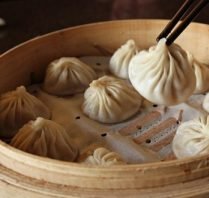
For those who are fully chopstick-competent, the traditional way of eating is to pick one up by the thick part at the top, dip it in vinegar and sit it in your spoon. Take a tiny bite out of the side of the dumpling and suck out the soup. The theory goes, the louder you slurp, the cooler the soup. Then dip the dumpling in the vinegar a second time and pop the whole thing in your mouth in one go.
For those too refined to slurp, punch a whole in the dumpling skin with a chopstick and tip the soup out into your spoon first.
You might guess a syringe, pouring the soup in before it’s sealed, or some kind of steeping process. Actually it’s much simpler: first they boil up the pork skin for a long time until all the collagen-y goodness boils out (it’s collagen, so it must be good for you!), then that mixture is strained and allowed to set into a gelatin. This gelatin is mixed in with the meat as a solid at room temperature, then when the dumplings are finally steamed the gelatin melts and creates the soup. Eat them while they’re hot or there’ll be no soup to be found!
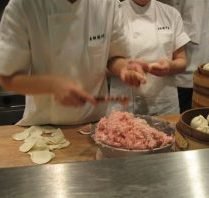
These tasty treats can be found all over Shanghai, and our carefully curated luxury China tours will introduce you to some of the best fine dining options. You can even drop by the famous Din Tai Fung, where you could try them filled with chocolate – not very traditional but fun nonetheless! Or for a more in depth sampling of these delectable buns alongside other tasty regional favourites, why not consider one of our evening food tours on offer?
– Kate is one of Imperial Tours’ China Hosts and a Shanghai resident.
Tomb Sweeping Festival, or Qingmingjie in Mandarin (pronounced Ching-ming-jair), is a three-day public holiday in China, making it the perfect time for a luxury China tour. Literally translating to the Pure Brightness festival, Qingmingjie is the day when people pay their respects to ancestors, traditionally by cleaning the graves and burning offerings. However, since this day usually falls on the 4th or 5th of April, the occasion is often used to mark the start of spring. Given the three day holiday, people may go on outings to enjoy the first hint of warmer weather, or even opt for domestic travel to another city, visiting the 5 Star offerings available in this fast developing luxury travel market.
Qingmingjie began over 2,500 years ago in the Zhou dynasty. Emperors and officials frequently held lavish ceremonies in honour of their ancestors, offering sacrifices and praying for a good harvest, health and prosperity. Over the years this morphed into the tradition of cleaning ancestors’ graves and burning food and paper, representing money, to bless them in the afterlife. The date of the festival, on the first day of the Qingming, or second, solar term, was fixed by Emperor Xuanzong, of the Tang dynasty, who decreed in 732AD that respect could only formally be paid at ancestors’ graves on this day. It’s a tradition since respected by officials and commoners alike.
Traditionally, Qingmingjie was the day when families would go together to the grave of their ancestors. They would spend the day digging up weeds, adding fresh soil and perhaps sticking willow branches, flowers or plastic plants on the tomb. They would also leave offerings of food and tea, or wine, as well as burning incense or artificial paper money, as it is believed that burning such things at a grave makes them available for use in the afterlife. They would also pray to their ancestors and ask them to watch over and bless the family.
If visiting friends or neighbours during this time, you’re likely to see willow branches hanging next to front doors to ward off evil spirits, which are thought to wander during Qingming. The use of willows specifically is homage to the Buddhist Goddess, Guanyin, who is usually depicted with a willow branch and a vase of sweet dew to banish demons. Guanyin also inspires the popular Hong Kong dessert, Yangzhiganlu (杨枝甘露), a feature of our popular food tour in Shanghai, as the sweetened coconut milk and sago in the dish represent the sweet dew and the willow branches.
Kite flying is also an important tradition of Qingmingjie. Young and old alike will often take to the park to fly kites with lanterns tied to the strings in the belief that this can bring good luck. Sometimes the kite strings will be cut, to allow the kite to fly free. Kites can even be seen flying into the evenings when the lanterns on the strings can appear like stars or fireflies dancing in the night sky. A fun activity for those travelling with children. Since the festival is marked by a three-day national holiday (actually just one day plus the weekends, as explained here), nowadays people often take the chance to celebrate the beginning of spring by taking a short trip out of the cities, or visiting parks and gardens to get glimpse at the emerging spring blossoms.
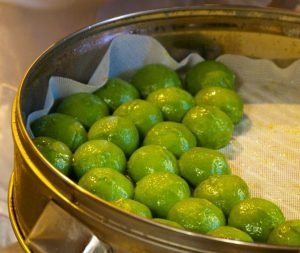
The most traditional food, which you’ll see everywhere in the weeks leading up to Qingmingjie, is undoubtedly the Qingtuan, literally meaniing “green ball”, and that is exactly what it looks like! A sticky, sweet, almost luminous green ball of paste wrapped in clingfilm and much tastier than the description would have you believe! The outside, green part is made of glutinous rice mixed with vegetable juice to produce the colour. Then inside is a sweetened red bean paste, which can sometimes be a bit of an acquired taste to the Western palette, but is a staple in many far eastern countries. The qingtuan is then eaten directly out of the clingfilm covering as a tasty sweet treat. Originally, Qingtuan were eaten on the “Cold Food Festival”, which was usually one day before Qingmingjie. However, over time, these festivals have merged together, and very few places now celebrate the two separately. Thus, the vast majority of people will tell you that Qingtuan are a traditional Qingmingjie snack.
Either way, if you’re visiting China in late March or early April, the Qingtuan really have to be tried! A food tour makes the perfect way to spend an evening on your luxury China tour, giving you an ideal opportunity to sample these special treats.
“I’m personally an atheist, but the concept of having a day to visit the family graveyard appears valuable to me, because I think sometimes it’s the living one that need to feel connected to a ‘root’.” -Sonia, 29
April is a wonderful time for a China tour, with the weather becoming pleasantly warm across the whole country. Many cities on your luxury travel itinerary will include the option to visit Buddhist or Taoist temples, where you can see, and even participate in, the practice of burning incense sticks. Traditionally three incense sticks are lit and held during prayer and this incense is available to buy near the entrance to most temples. The Lingyin Temple in Hangzhou is particularly special, since just outside it is a long promenade with caves containing statues of many different Buddhas carved into the rock. A rare and impressive site! It’s also joined to the luxurious Aman hotel, offering indulgent massages and spa treatments after a long day’s touring.
As you visit Shanghai, keep your eyes open in the markets of Yu Gardens too, as you may see some of the paper money to be offered as a sacrifice available to buy. An unusual and poignant souvenir for those wishing to tell stories of the cultural tradition of Qingmingjie on their return home.
Mainland China has six main holidays every year in addition to New Years on January 1st which it celebrates in tandem with the rest of the world. The majority of China’s festivals follow the Lunar calendar and are based upon the monthly cycles of the Moon’s phases. Of the six holidays, two are labeled “Golden Week” holidays because they last seven consecutive days. The others comprise of one day holiday.
In practice, a unique feature of mainland Chinese holidays that differs from other countries is that weekends are usually substituted with weekdays next to the actual holiday so as to create a longer 7-day “holiday” period when in actual fact workers only get three days off. It is therefore common for staff working in Chinese companies to work during weekends to make up for this. For example, if the 3 days holiday lands from a Monday to Wednesday, the government will give everyone Thursday and Friday off as well, which added to a weekend equals to seven consecutive days off. However, workers will need to work the weekend prior.
Below is a recap of China’s holidays, as well as advice for what which you’ll want to avoid when planning a private luxury tour with Imperial Tours. Note that Hong Kong and Macau observe slightly different holiday schedules, with some festivals inherited from their respective colonial days.
Also known as Chinese New Year, Spring Festival is one of the most festive holidays in Chinese culture when families gather in the ritual of reunification to send off the old year and greet the new one. Typically an indulgent meal is prepared on New Year’s Eve that includes staples such as dumplings, noodles and fish which are symbolic of longevity. Red clothing is worn, couplets with good wishes adorn doorways, red packets of money are distributed to children, and over the course of the holiday fire crackers are set off to ward off evil spirits (though in recent years the government has limited this due to noise pollution and safety). Spring Festival is one of two ‘Golden Weeks’ where an official “7-day” holiday encourages much of the population to return home, thereby marking the planet’s largest annual human migration with roughly 3 billion passenger journeys taking place, straining transport routes and quite literally reducing the world’s largest economy to a shuddering halt.
Is this a good time to travel? Although temperatures are cold at this time of year, as long as one packs appropriate cold-weather gear and is prepared, it’s a good time to visit China because tourist sites tend to be less crowded.
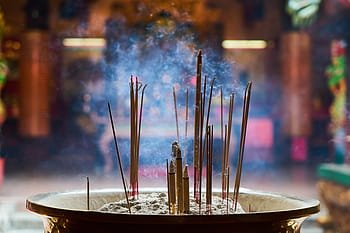
As its name indicates, this holiday commemorates and shows respect to ancestors. Relatives visit graves, offer food, tea or wine to the deceased, burning incense and offering joss paper (representing money … because one still needs cash in the afterlife). Observed by the Han Chinese, families travel to ancestral burial sites to sweep tombs, remove weeds and add fresh soil. Qing Ming Jie was not ‘officially’ celebrated as a day off in the PRC until about a decade ago. When the communist government took power in 1949, they scrapped traditional holidays from their calendar but when China’s May Holiday Golden Week was scaled back in 2007, three traditional holidays were brought back: Qing Ming Festival, Dragon Boat Festival and Mid-Autumn Festival (more on all these holidays as you read on).
Is this a good time to travel? Since this is a short holiday, it’s generally fine to travel during this holiday. We might advise that you avoid certain cities where roadways can become congested and affect touring such as in Hangzhou.
The literal translation for “Wu Yi Jie” is May 1st Holiday. Like many other countries, China celebrates May Day to commemorate its workforce. It was officially established and approved as a holiday by the Chinese government in 1949 following the formation of the Peoples Republic of China. During the Cultural Revolution, this day carried political significance and was considered one of the most important holidays in the country and lasted 7 days. At the time, nationalistic rallies and demonstrations were organized to celebrate its workers, however, today the nature of the holiday has evolved, lending to a more cheerful and casual family holiday with just one day off. As mentioned earlier, in 2007 they reduced this holiday to one day therefore freeing days to dedicate to other holidays.
Is this a good time to travel? Yes, generally a good time with ideal weather in most destinations.

This festivity takes place on the fifth day of the fifth month of the traditional Chinese calendar usually falling in June. Although legendary origins of the Dragon Boat festival vary regionally with an over-arching theme of water-related tragedies, they all carry traditions in Chinese culture such as virtue, spirit, loyalty, honor and love. Dragon Boat Racing is the highlight of this holiday with spectators swarming to watch teams competing in wooden boats shaped and decorated in the form of the dragon and manned by 30 to 60 people paddling harmoniously and swiftly to the sound of beating drums. Hong Kong and Hangzhou are where the most lively dragon boat racing spectacles can be enjoyed.
Is this a good time to travel? Yes, it’s a good time and if you are in the right city, you’ll be able to catch some Dragon Boat races.
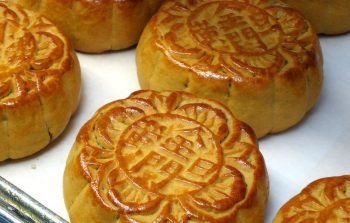
Several varying myths surround the genesis of the Mid Autumn Festival. According to one legend, the moon goddess Chang’e overindulged on an elixir and flew to the moon with her rabbit companion. Another tale says that Chinese emperors in the Zhou dynasty (1045-221 BC) worshipped the moon to bring a bumper harvest the following year. Whatever origin one might believe, this festival is marked by not only distributing moon cakes to family members and colleagues, but also eating them, of course. The densely packed pastries often presented in gorgeous packaging traditionally come with all sorts of fillings such as salty egg yolk (perhaps an acquired taste?), lotus, red been or date paste. Now with a bit of creativity it’s rather common to find moon cakes filled with butterscotch, ice cream or chocolate!
Is this a good time to travel? Yes, very good weather at this time of year.
On October 1st 1949, in front of a crowd of 300,000 people in Tiananmen Square Chairman Mao declared the People Republic of China’s National Day. Called guoqqingjie, the ‘Golden Week’ holiday celebrates the founding of the People’s Republic of China by the Communist Party. Large-scale military displays and parades are held to mark major anniversaries; the last impressive military display took place for the seventieth anniversary of the PRC founding in 2019 resulting in road closures in cities such as Beijing and Shanghai.
Is this a good time to travel? If you can avoid it, it is advisable not to travel domestically during the week around October 1st. Since it is a popular time for domestic tourists to see the country, tourist sites are packed with local travelers.
(These are the official 2020 dates released by the China State Deparment)
– Nadia is one of Imperial Tours’ itinerary designers.
FOR IMMEDIATE RELEASE: August 14, 2017
Contact: Jacqueline Soto, 480-430-7511, Jacqueline@slentertainment.com
Guy Rubin, +86 10 8440 7162 guy@imperialtours.net
IMPERIAL TOURS GREAT WALL PRIVATE BANQUET RECOGNIZED AMONG TOP TRAVEL EXPERIENCES
Scottsdale, AZ – An experience offered by Imperial Tours was recognized as one of the top experiential travel offerings at the inaugural CHAD CLARK CERTIFIED 25, a first-of-its-kind travel initiative that annually lists the top 25 travel experiences or products throughout the world. The winners were announced in a special interactive event at the Bellagio in Las Vegas on August 13 in front of leading travel professionals.
Chad Clark, principal and owner of Chad Clark Travel Ventures, is a travel industry expert and self-described, “experience junkie,” who has spent years seeking out top-of-the-line travel experiences and services. Now, he is providing a platform for the best in travel to share theirs.
Clark aims to set the industry standard for luxury travel with the inauguration of the CHAD CLARK CERTIFIED 25, an elite list of the world’s most prestigious, authentic and unique travel experiences or products. Great Wall Private Banquet was among the first recipients of this prestigious honor.
“We are humbled and overwhelmed by the immense number of submissions we received from travel providers across the globe,” said Clark. “It is an honor and a thrill to unveil the very best in luxury travel through the CHAD CLARK CERTIFIED 25. This initiative provides travel suppliers with an opportunity to have their premium experiences recognized and promoted in an innovative way, while simultaneously connecting travel advisors, and ultimately travelers themselves, with exclusive, thoroughly vetted travel experiences that have an industry seal of approval.”
About the Great Wall Banquet
When we hear these days of the daunting logistical and financial challenges of building a wall across the southern border of the US, it brings home the magnificent achievement of the Chinese in resolving exactly these issues many centuries before as they built successive fortifications across their northern frontier to protect their agricultural heartlands from aggressive nomadic invaders from the north. These fortifications are known to us today as the Great Wall of China. The incredible experience we are presenting is the opportunity to walk the Great Wall with the British conservationist who was instrumental in developing the law to protect it, and then to enjoy a white linen banquet in a guard tower.
What astounds visitors about the Ming dynasty Great Wall (1368-1644) is its surprising beauty. Whereas the sections closest to Beijing are the largest with the most tourists, more remote sections benefit from fewer visitors and less renovation. The centuries-old 5 meter high “wild wall” – as conservationist William Lindesay calls it – these days does not dominate its surrounding landscape so much as delineate, define and embellish it. William will introduce his thirty year association with the Great Wall, starting with being the first foreigner ever to walk its entire length, to now when he is known through China as the Guardian of the Wall. After a thorough introduction to his efforts to improve its conservation, you will be taken to a remote spot to enjoy a remarkable banquet on the Great Wall of China.
About Chad Clark Travel Ventures
A self-proclaimed “experience junkie,” Clark gave up corporate life to follow his love for food, wine, culture, destinations, a.k.a. extraordinary travel experiences, and turn it into a business that helps people make the absolute most of their most precious commodity – their time.
Whether traveling with friends, family or alone on a research trip, Clark is all about the experience – and when he finds one he is passionate about, he just has to share it with his clients and friends. He and his company have the contacts, relationships and dedication necessary to ensure his clients have the best possible experiences. Clark has dedicated his life to travel and is amassing an ever-growing “Experience Journal” that he shares online through social media. Viewers can follow Clark through Rome, Sydney, Paris and even in his own backyard golfing in Scottsdale, Arizona. Clark and his team are committed to sampling, connecting, building relationships and, in essence, helping his clients live their next big adventure.
Chad Clark Travel Ventures works with people who recognize that the types of trips they want require more than time and planning – they require knowledge, experience and connections, all of which Clark and his team can provide.
Chad Clark Travel Ventures, an independent affiliate of Camelback Odyssey Travel – a Virtuoso® Member.
For more information on CHAD CLARK CERTIFIED 25, please visit www.chadclarkcertified.com.
Wolfgang Puck, the famous Austrian-born American chef and restaurateur has brought his acclaimed American casual dining concepts to China for the first time. Wolfgang’s new hot spot is perfectly situated in the hip and affluent shopping and eating district of Xintiandi in Shanghai. And as there was a new celebrity chef restaurant in Shanghai, my friend and I felt obliged to experience it first hand. The outside of the restaurant was inviting with a soft gray brick exterior contrasting with rich wooden doors and flowing metal vines swirling through the windows. Walking in, we found the restaurant was quite full, with over two thirds of the place filled up. The décor inside made use of natural materials to deliver a modern atmosphere with a casual and elegant feel. Wood floors, soft leather chairs, granite tabletops and exposed light fixtures exuded a warm and urban atmosphere. This minimalist concept created an elegant and casual feel, which extended to the seating area on the terrace. Since it was a beautiful spring day in Shanghai, we opted for a table outside. As we took our seats on the terrace we decided it was the perfect spot to watch the world go by on a Saturday afternoon as friends, couples and families made their way through the streets with parcels in hand and smiles on their faces. After we had settled into our seats a server immediately came over with a menu. The western style menu was not overly extensive, but it had something to satisfy everyone’s tastes. The menu featured some of Wolfgang’s signature dishes such as handmade pizzas as well as a selection of salads, steaks, roast chickens, seafood dishes, pasta and the best part – desserts. The price range of each item on the menu fell between the range of $15 for a salad to around $45 for a steak.
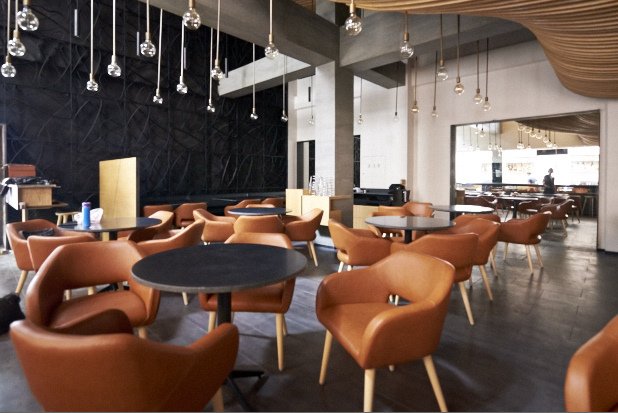
Urban interior décor
After going over the menu and discussing the pros and cons of each dish and what we were in the mood for, my companion opted for the Roasted Sea Bass accompanied by garlic spinach & charred lemon, while I decided on the Garlic & Herb Marinated Half Chicken with rosemary jus sauce. In addition to our mains we decided to share the Shrimp ‘Louie’ marinated in a tomato sauce as an appetizer and the Vanilla Bean Crème Brûlée with seasonal fruit for dessert. Following a casual catch up conversation our appetizer arrived. The Shrimp Louie turned out to be an excellent choice and a good portion to share between the two of us. Conversation ceased as we both tucked into the dish, agreeing we had made the right decision with the shrimp. After the remains of our starter were cleared away my companion and I continued to catch up on the happenings of our day-to-day lives while enjoying the lively atmosphere of Xintiandi’s pedestrian street. Xintiandi is one of the most popular shopping areas for young and well-to-do Shanghainese and foreigners alike so there is always something to see, do or eat.
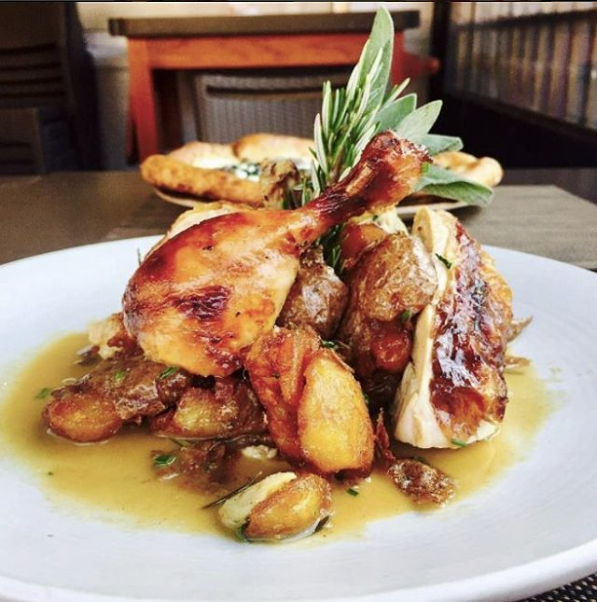
Garlic & Herb Marinated Half Chicken
Our food arrived in good time and when it did we discovered it had been a wise decision to share both the appetizer and dessert, as the portion size of our mains was huge. Although the bar & grill had a European meets Asia flair the portion sizes were certainly American. Our two mains could have easily fed a family of four. Never one to complain about too much of a good thing, my companion diligently began to eat her fish, while I endeavored to enjoy my chicken. After a chatty pre-meal conversation, silence ensued as we attempted to tackle our mains, that is until about half way through eating when I glanced up at my friend and in a defeatist tone admitted: “I don’t think I can finish this.” Looking up bemused, with a smile on her face she joked, “I don’t blame you. When it arrived I wasn’t sure whether you would eat the chicken or the chicken eat you!”

Créme Brûlée
By the time our Crème Brûlée arrived we were already full, but of course we had to try it. Like the other items we ordered the serving was quite large, presented in a dish the size of a soup bowl. With its golden-brown crust and vanilla-coloured crème hidden beneath, it looked too good not to try. Although rather sweet for my taste the Crème Brûlée had the perfect balance of crispiness and vanilla bean crème, it was absolutely delightful. I am not ashamed to admit that we finished the entirety of our dessert. At the end of it all both my companion and I were bursting! The bill for the two of us ended up being USD$120, without ordering drinks. Overall, our food was good. The star of the meal was the Crème Brûlée followed by the Shrimp Louie. Our mains were satisfactory, the chicken wasn’t too dry and the roasted bass was also well prepared, although nothing to write home about. However, it was the sheer size of the portions that was a bit intimidating and left the biggest impression. Overall, it seemed like a good place for families, as the menu had a large selection of child friendly options. The atmosphere was very family friendly as well – relaxed casual environment where parents and kids alike could relax and enjoy a good meal.
– Restaurant was reviewed by Lotus Qi, China Host at Imperial Tours.
Learn more about Imperial Tours’ unique culinary experiences here.
The Year of the Rooster
Chinese New Year, also referred to as Lunar New Year and Spring Festival, is the biggest and most important holiday in China. In terms of significance in Chinese culture the Lunar New Year is comparable to combining Thanksgiving and Christmas together. We have assembled some traditions and facts behind one of the world’s largest celebrations to provide a better understanding of this holiday. We have also put together some useful travel tips should you wish to experience this festival first hand.
The tradition of Chinese New Year is said to have started thousands of years ago when, at the end of a cold and hard winter, a mythical beast called Nian would storm into Chinese villages and devour all the men, women and children residing there. Full of fear and with no means to defend themselves the villagers would hide in the surrounding bamboo forests to wait out the night and the wrath of the beast. Until one year, tired of hiding, a brave old man decided to face the beast alone. In preparation for his fateful encounter, the old man hung up red flags and banners; he then cut fresh bamboo to light a fire. Once on fire the green bamboo created such loud cracking sounds that the monster, upon hearing the noise and seeing the many red colors, was scared away. And so as legend goes, from that day on people no longer had to fear the beast. Advancing forward thousands of years, it is now tradition that at the end of winter people across China gather together to celebrate, hang red banners and lanterns, wear red clothing and light firecrackers.
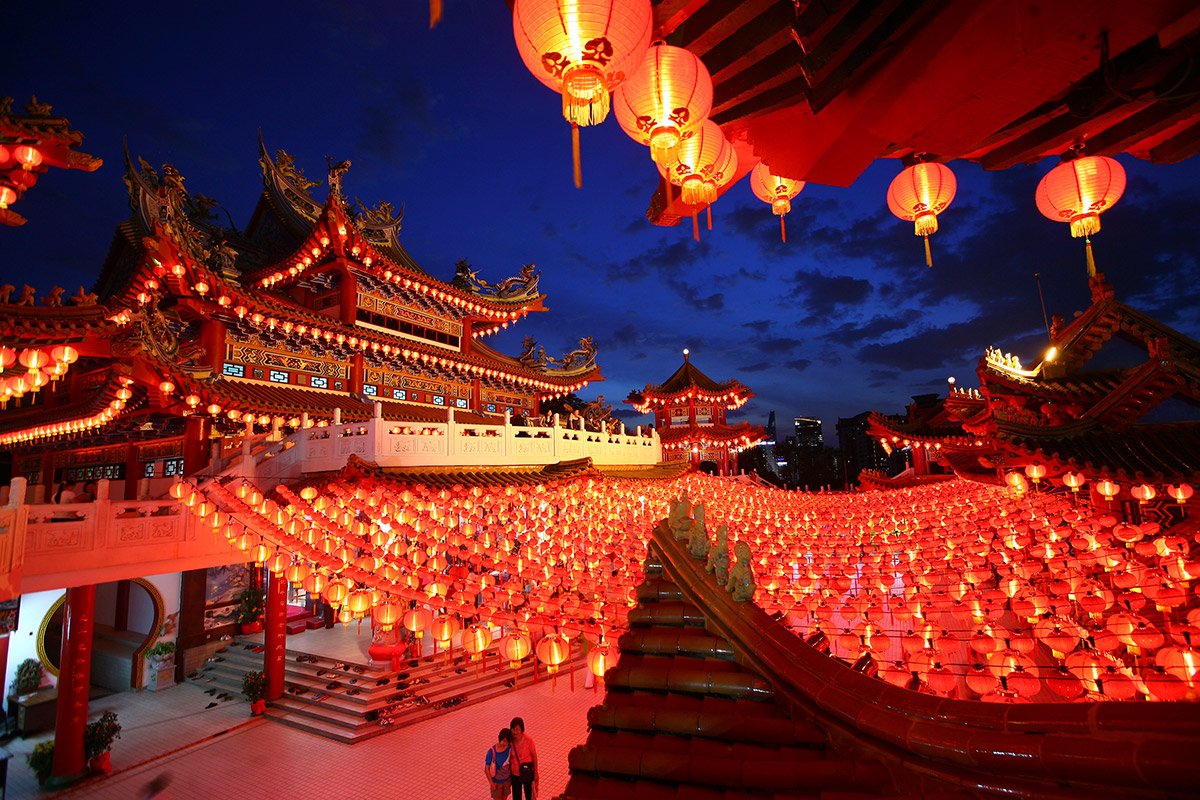
Red Lanterns in Beijing at Chinese New Year/span>
Chinese New Year is a 15-day celebration following the lunar calendar, this means that the date of the holiday changes each year. Generally, Chinese New Year falls between the end of January and the beginning of February. In 2017, January 28th was the first day of the New Year, marking the beginning of the year of the Rooster. Outside China countries such as Indonesia, Malaysia, South Korea, Taiwan and Singapore also recognize and celebrate the festival. Chinese New Year is actually the biggest migration on earth. Over the holiday there are an estimated 650 million people traveling, either throughout China or overseas to visit friends and family. Much like Christmas and Thanksgiving, in Chinese culture over the Lunar New Year it is customary for families to spend time together. For those individuals who have have moved into bigger centers, such as Beijing or Shanghai for work or study, the New Year festival is a time to travel home. For many people, this is the only time of year when they will have time to reunite with their families. Officially, this mass migration begins two weeks before New Years Eve and ends two weeks after; this transport period is referred to as Chun Yun. The Chinese New Year festival is also responsible for the largest television broadcast in the world. Since 1983, CCTV (China Central Television broadcasting company) has hosted a lavish six-hour Spring Festival Gala. The gala is called Chun Wan and is essentially a variety show featuring traditional Chinese performances showcasing China’s vast culture and history. With approximately 800 million viewers, this is the largest entertainment show broadcast globally. Since its origin, Chinese New Year has evolved to incorporate new customs and traditions, which can vary from place to place and family to family. However there are some universal traditions that the majority of those celebrating Chinese New Year recognize. We have created a list of seven common customs followed during the New Year festival.
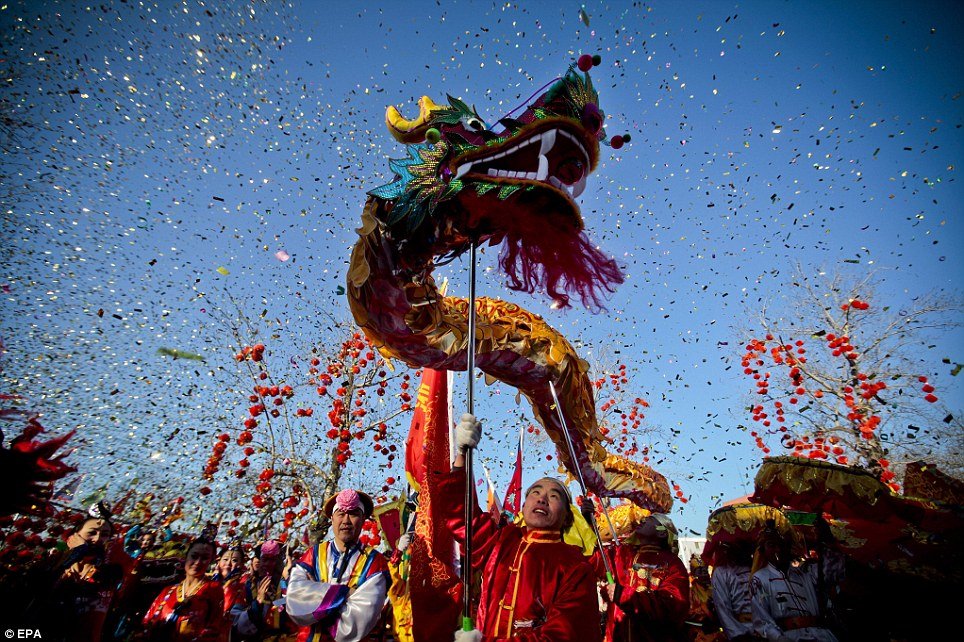
Traditional Chinese New Year Customs
Spring-Cleaning
Several days before the Lunar New Year is set to commence it is customary to perform a spring-cleaning of your home to sweep any ill fortune away. This is also the time to stock up on snacks and food to prepare for the festivities, much like what happens in the days prior to Christmas. This preparation is important as during Chinese New Year it is believed that one should do as little work as possible. It is also considered bad luck to use a knife, light a fire or even use a broom on the first day of the New Lunar Year.
Traditional Red Clothing & Decorations
In line with tradition, at Chinese New Year it is customary to decorate your home with traditional red lanterns and red banners. Across China red banners with auspicious poems written on them are hung outside doors to bring good fortune, wealth, happiness and longevity. In ancient China, New Year was also typically the time when people bought or traded for new clothing. In present-day China, it is customary to buy and wear red clothing, even underwear during this period.
Family Gatherings
It is traditional on New Years Eve for the family to congregate at the husband’s family home, then, on the second day of the New Year, the family would go to their maternal relatives for a visit and celebration. However, during the Lunar Festival the theme is generally ‘the more the merrier’ and generally distant relatives will gather together to celebrate regardless of family ties.
Lucky Foods
Symbolism in China is of utmost importance; even the food that is served and consumed during the New Year festival holds significance. Traditionally, fish is eaten for the New Year’s meal. In Chinese the word fish (yú) sounds similar to the Chinese word for ‘surplus’. Fish is consumed to ensure that each year there will be surplus. However, the fish is never eaten completely as this again symbolizes surplus. Other ‘lucky’ foods include mandarin oranges (júzi) as their name is a homophone of the word for success in Chinese. Another popular food with homophonic meaning is Niangao or glutinous rice cake, which sounds like ‘a more prosperous year’. Additionally, spring rolls and dumplings are eaten because of their similarities to ancient Chinese silver and gold ingots.
Firework Displays
In line with the tradition to scare away the Nian, at midnight on New Years Eve, to ring in the New Year people all over China go outside to set off a barrage of firecrackers and fireworks. However, this practice is not restricted to New Years Eve alone, every night for the next two weeks fireworks are lit until the last day of the festivities when anything that is left is set off.
Temple Visits & Temple Fairs
After the festivities and fireworks the night before, on the morning of New Years Day people congregate at Buddhist temples to give their offerings to the gods. While not everyone in China practices Buddhism, many Buddhist traditions have intermixed with folk customs and it is customary to burn incense at the temples as well as make a donation to wish for a smooth and successful next year. This is often combined with a visit to a traditional temple fair.
Traditional Gifts The five days following New Year’s Day are dedicated to eating, drinking, visiting relatives and playing mahjong. During this time it is traditional for older relatives to give children gifts of red envelopes with money called Hong Bao. The values vary from family to family, but typically Hong Bao’s consist of monetary values containing lucky numbers such as 6, 8 or 9. With the advancement of technology it has now also become popular for friends and family to send each other Hong Bao’s over the messaging service Wechat.
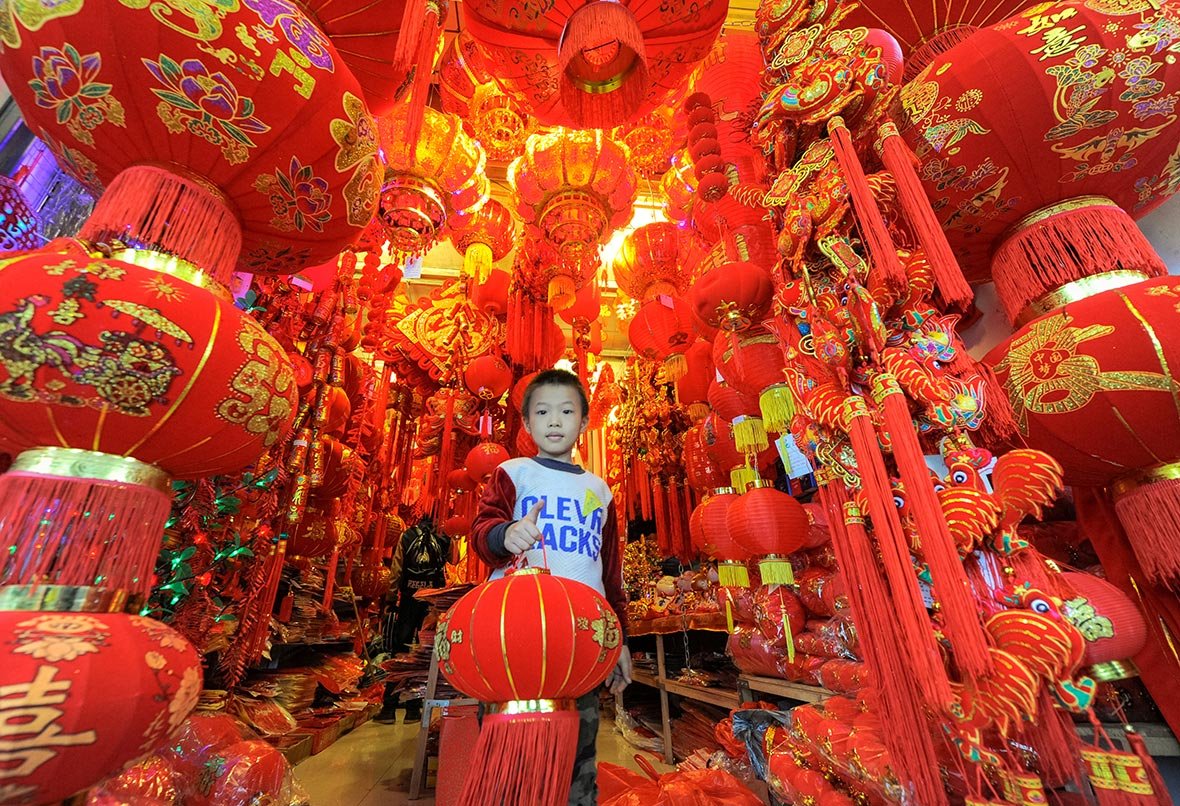
Traveling During the Chinese New Year Festival
Because most businesses are closed for the holiday, we do no recommend traveling during the first week of Chinese New Year. However, in the second week business starts to picks up again, as people return from their holidays the hustle and bustle of modern China slowly returns. If you do wish to come during this period there are some fun and cultural experiences we recommend doing.
Attend a Temple Fair
Visiting a Chinese New Year Temple Fair, called a Miao Hui, is a great way to experience Chinese culture around the Spring Festival. These temple fairs are set up in large city parks and feature arts and crafts as well as traditional performances. Many temple fairs have evolved into bazaar-like events with parts of the park dedicated to arcades where one can try one’s luck at winning an oversized teddy bear and various other prizes. These fairs are also great for trying a multitude of traditional Chinese snacks that are often only available during Chinese New Year.
Fireworks
Over 2,000 years ago China invented fireworks, so it is no surprise that watching and lighting fireworks during the New Year festival can be quite inspirational. On every large street corner temporary shops set up selling boxes of fireworks of various types. During the festival you can expect to see firework displays every evening. In recent years the government has tried to discourage citizens from lighting fireworks in the city due to fire hazards, but this rule goes largely ignored and is often not enforced.
Chinese Zodiac Animals
|
|
Characteristics |
Years |
|
Rat |
Intelligent, adaptable, quick-witted, charming, artistic & sociable. |
2020, 2008, 1996, 1984, 1972, 1960, 1948 & 1936 |
|
Ox |
Loyal, reliable, thorough, strong, reasonable, steady & determined. |
2021, 2009, 1997, 1985, 1973, 1961, 1949 & 1937 |
|
Tiger |
Enthusiastic, courageous, ambitious, leadership, confidence & charismatic. |
2022, 2010, 1998, 1986, 1974, 1962, 1950 & 1938 |
|
Rabbit |
Trustworthy, empathic, modest, diplomatic, sincere, sociable & caretakers. |
2023, 2011, 1999, 1987, 1975, 1963, 1951 & 1939 |
|
Dragon |
Lucky, flexible, eccentric, imaginative, artistic, spiritual & charismatic. |
2024, 2012, 2000, 1988, 1976, 1964, 1952 & 1940 |
|
Snake |
Philosophical, organised, intelligent, intuitive, elegant, attentive & decisive. |
2025, 2013, 2001, 1989, 1977, 1965, 1953 & 1941 |
|
Horse |
Adaptable, loyal, courageous, ambitious, intelligent, adventurous & strong. |
2026, 2014, 2002, 1990, 1978, 1966, 1954 & 1942 |
|
Sheep |
Tasteful, crafty, warm, elegant, charming, intuitive, sensitive & calm. |
2027, 2015, 2003, 1991, 1979, 1967, 1955 & 1943 |
|
Monkey |
Quick-witted, charming, lucky, adaptable, bright, versatile, lively & smart. |
2028, 2016, 2004, 1992, 1980, 1968, 1956 & 1944 |
|
Rooster |
Honest, energetic, intelligent, flamboyant, flexible, diverse & confident. |
2029, 2017, 2005, 1993, 1981, 1969, 1957 & 1945 |
|
Dog |
Loyal, sociable, courageous, diligent, steady, lively, adaptable & smart. |
2030, 2018, 2006, 1994, 1982, 1970, 1958 & 1946 |
|
Pig |
Honorable, philanthropic, determined, optimistic, sincere &sociable. |
2031, 2019, 2007, 1995, 1983, 1971, 1959 &1947 |

Marketing China has never been more exciting, easy and profitable. As you may know Imperial Tours has partnered with Peninsula Hotels to bring you Peninsula Private Jet Tours Through China. Through this collaboration we have developed three bespoke travel experiences through China: Culture & Heritage, Family and Culinary. But what you may not know is that we have also developed a marketing plan designed to help you get the word out about these itineraries. Our Marketing Plan gives you the tools you need to promote and share Peninsula Private Jet Itineraries through multiple mediums. The idea behind sharing our marketing plan with you is to take the guesswork out of promoting these experiences. Essentially, let us do all the work for you and all you need to do is share!
These itineraries are packed full of once-in-a-lifetime experiences. If they are booked privately, itineraries can be further customized for alternative dates or embellished with different destinations, and if wished they can also be booked on commercial flights.
Our Marketing Calendar (click to download) is complete with step-by-step instructions on how to market and capitalize on each itinerary. All you have to do is follow five easy steps and let Imperial Tours do the rest.
Follow us on Twitter, Facebook and Instagram to get content on Peninsula Private Jet Tours that you can share with your followers.
Click to download our Marketing Calendar made especially for you. This calendar provides you with a detailed, easy to follow, marketing campaign that you can print out and follow to promote these tours. Additionally, our Marketing Calendar provides you with easy to follow instructions on how to repost and share from Facebook, Twitter, Instagram and E-blast.
Over the next 3 months, starting in November 2016, we will be sending out 3 e-blasts relating to a specific Peninsula Private Jet Itinerary; Culinary, Family and Culture & Heritage. Each e-blast will be created so that you can forward the information to anyone you think might be interested in one of these amazing experiences.
Each one of our 3 e-blasts will have a social share button that allows you to share each itinerary on Twitter, Facebook & Instagram. Simply click the social share button for each social icon and share!
After generating interest in each tour contact us to help you book one of these amazing journeys. Note: private tours based on these scheduled departures can fly commercial and be further customized.
Our Culinary Voyage e-blast will be sent shortly after American Thanksgiving. This one of a kind itinerary provides opportunities for your clients to try their hand at creating traditional Chinese dishes such as Peking duck, Dim Sum and even noodle throwing. China is a “must-eat” destination for all foodies; our Culinary Voyage is a 10-day tour highlighting the best eats China has to offer. Our culinary tour is ideal for groups of 8 or less. Tours are approximately USD$26,050* per person based on double occupancy. To view a detailed itinerary click here.
Our Family Tour e-blast will be sent in early December, in time for Christmas as the perfect once-in-a-life-time holiday gift for the whole family. This 11-day tour showcases the best of China in a safe and family-friendly interactive setting. This tour is ideal for small to medium sized families who are looking for a unique holiday experience and enjoyment for the whole family. Tours begin at approximately USD$102,120* per family of 4. To view a detailed itinerary click here.
Our Culture & Heritage itinerary will be sent out after the New Year and is equipped with unparalleled access to some of China’s most significant cultural artifacts as well as leading creative minds shaping China’s artistic landscape. This 10-day tour will introduce you to private collections and VIP access to China’s cultural treasures. This tour is ideal for clients who are looking for exclusive access to all that China has to offer. This tour is suitable for small groups as well as families. Pricing begins at approximately USD$25,530* per person based on double occupancy. To view a detailed itinerary click here.
*Price is subject to change based on fluctuating exchange rates.
Imagine exploring three of the worlds most dynamic and fast paced cities from the comfort and convenience of a private jet. Imperial Tours has partnered with Peninsula Hotels, renowned for flawless service and quality, to provide you with the ultimate China experience, Peninsula Hotels’ Private Jet Tours. We have crafted three themed itineraries – Culinary, Family and Culture & Heritage – each designed with immersive experiences to captivate you while introducing the rich culture, cuisine and history of China.

Experience a journey like no other on a Peninsula Private Jet Holiday
For many people, the thought of visiting China sparks a sense of wonder and excitement for the mysterious culture of the East. As one of the most populated and diverse countries in the world, China provides a cornucopia of experiences engaging all the senses. While this temptation to discover the East is an enticing lure it can also be overshadowed by fear of the unfamiliar. With Peninsula Hotels’ Private Jet Tour itineraries you will experience the reassuring comforts, anticipatory service, and soothing attention to detail of legendary hotelier, Peninsula Hotels. In this way, the exoticism and mystery of the East can be enjoyed from the reassuring platform of some of the world’s leading hotels.
Each tour provides access to one-of-a-kind bespoke experiences only available as a result of the partnership between Imperial Tours and Peninsula Hotels. For example, you will explore a seafood bazaar in Hong Kong with the Executive Chef of the Peninsula Hong Kong and learn to paint with the Peninsula Beijing’s resident artist. Alternatively, try climbing aboard Peninsula Shanghai’s private yacht for an architecture tour of its future cityscape from the Yangzi River. Each itinerary features unique hotel experiences in China born of the collaboration between Peninsula Hotels and Imperial Tours.

Private access to world renowned cultural sites is merely a starting point for our Culture & Heritage tour. Apart from meeting with some of the most influential leaders in China’s arts and culture sector, you will also view rare art collections normally closed to the public. For instance, you will tour meet and enjoy lunch with the founders of China’s leading home-grown auction house and also tour private galleries in Beijing and Shanghai with gallery owners. In Beijing, you will not only enjoy a private lunch al fresco on the Great Wall of China but also meet with the conservationist responsible for the law protecting it.
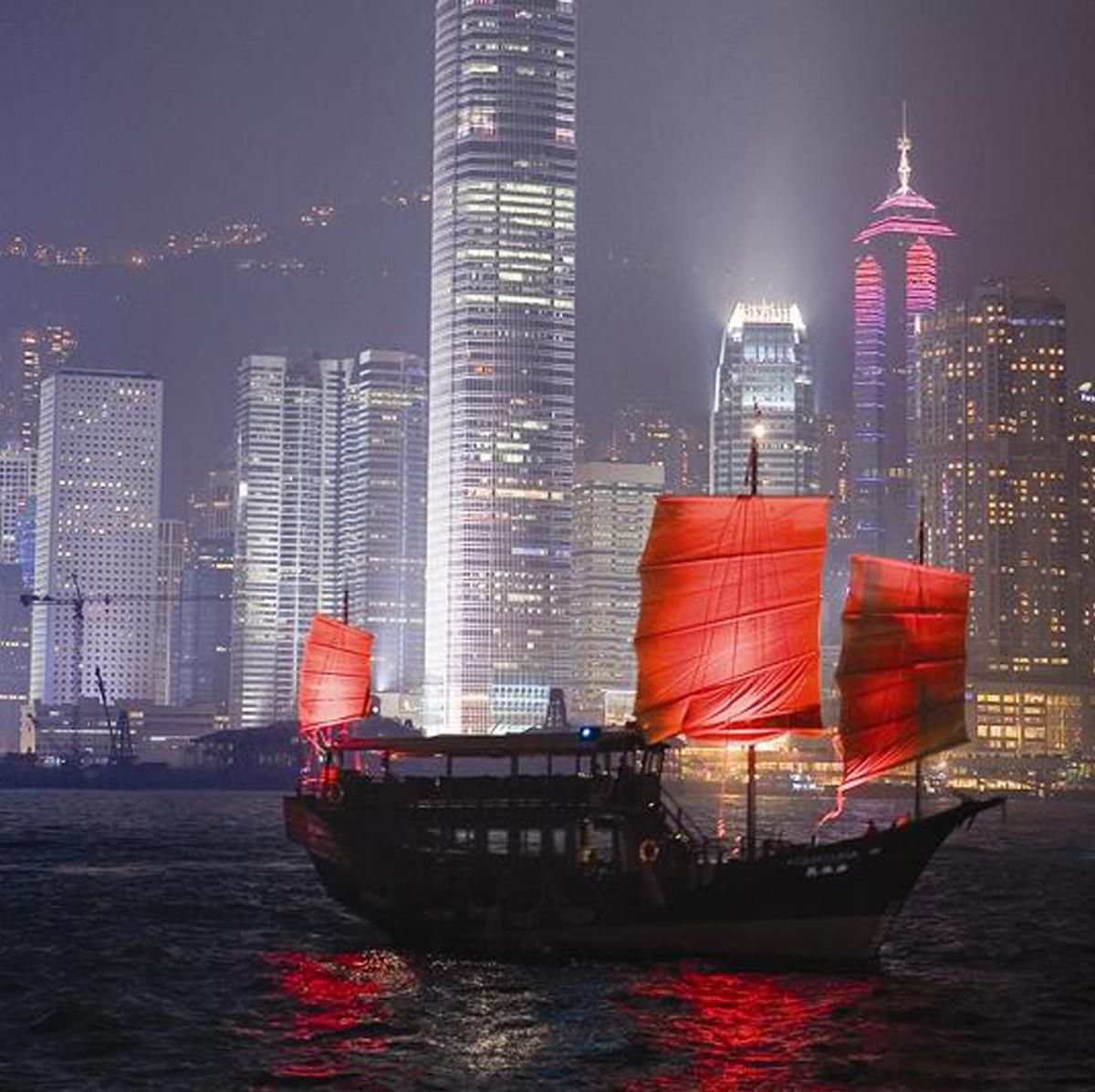
Culture & Heritage Tour, uncover the mysteries of the east from the comfort you can only experience with Peninsula Private Jet Tours
A family vacation by private jet not only eases the stresses of traveling with a family; it also provides a relaxing environment to connect and spend quality time together between destinations. Enjoy the ultimate family vacation in China with experiences ranging from a Chinese cooking lesson with a Peninsula Chef to painting lessons with the resident artist in Beijing’s Peninsula property to playing table tennis with a former Chinese Olympian. Other highlights on our Family Tour include, hand-feeding pandas and enjoying VIP access to the newly opened Shanghai Disney. We have curated only the best experiences to ensure that each member of the family is captivated and entertained, providing you with a relaxing, memorable and safe vacation abroad. Make your next family vacation one filled with unforgettable experiences sure to entertain, bring you closer together as a family and introduce your children to the magnificence of China.
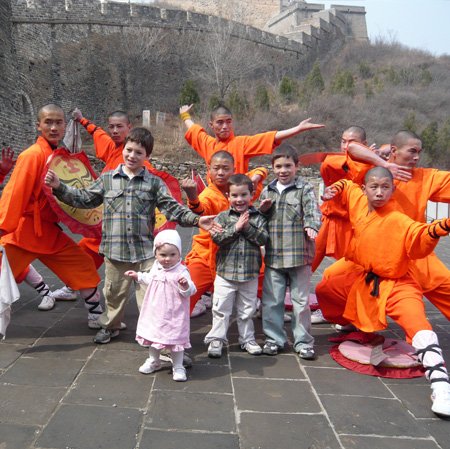
Family Tour, give your family an experience they will never forget from the safety and comfort of a Peninsula Private Jet Tour
China is a “must-eat” destination for foodies everywhere and our Culinary Voyage private jet tour offers the best China has to offer. Given our destinations of Beijing, Shanghai and Hong Kong, we focus on three main schools of cuisine; Imperial, Huaiyang and Cantonese from the perspective both of fine dining and home-style cooking. Together with Peninsula Hotels we have created a tour that provides exclusive access to Peninsula’s private kitchens as well as opportunities to learn, shop and cook with the best. For example, the Executive Chef of the Hong Kong Peninsula accompanies you on a traditional junk to his favorite island seafood bazaar. Alternatively, a TCM qualified nutritionist introduces you to China’s leading farm to table organic restaurant specializing in traditional cooking techniques. You will be introduced by experts to the art of preparing and cooking some of China’s most famous dishes from Peking duck in one of Beijing’s top duck restaurants to hand thrown noodles and dim sum. No matter your palette, our culinary tour will leave you with a newfound appreciation for the range and art of Chinese cooking.
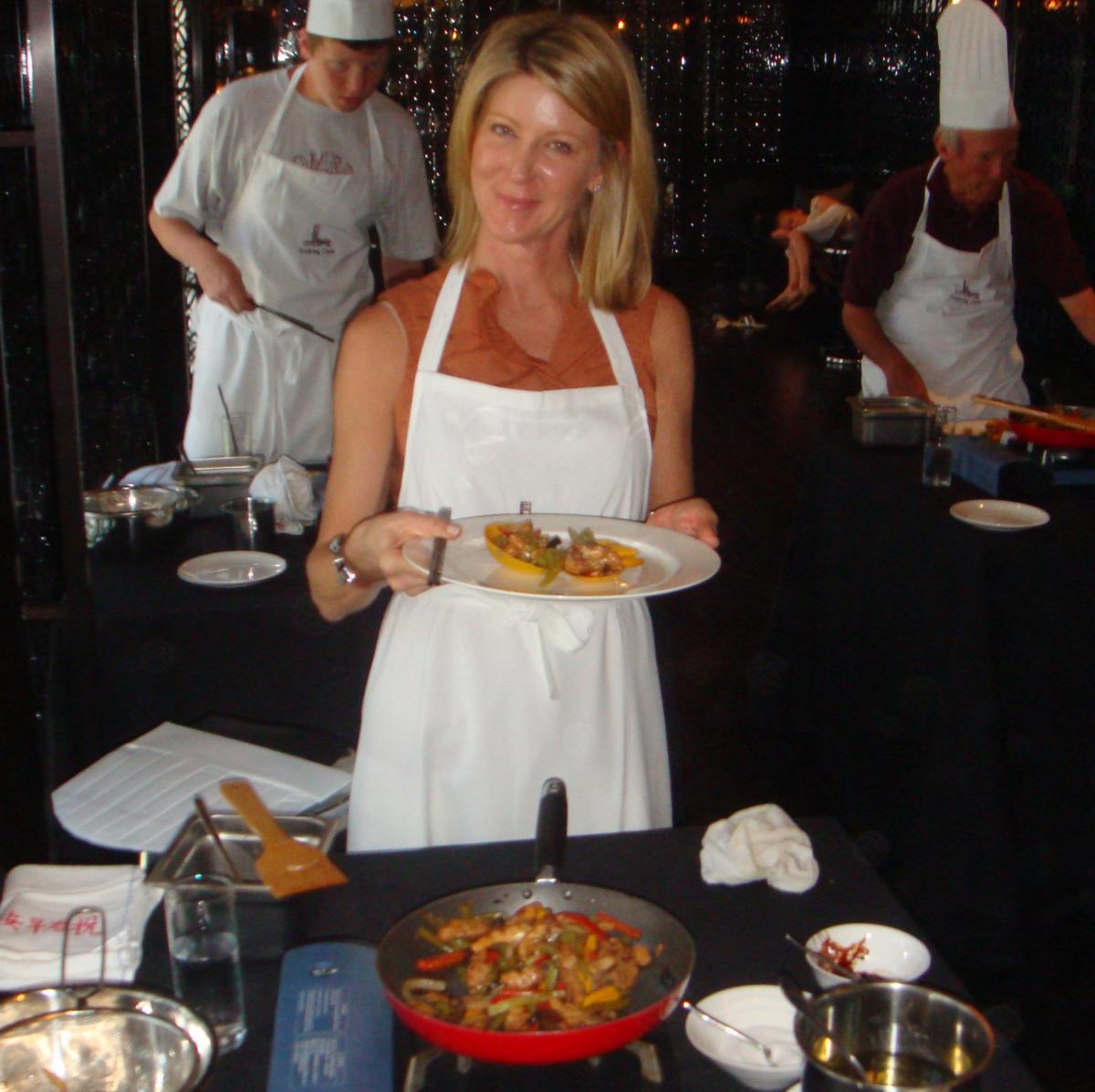
Culinary Voyage, learn the art of creating some of the most iconic dishes in Asia with Peninsula Hotels & Imperial Tours
Flying on a private jet not only enhances your comfort, it also allows you to see and do more in a shorter amount of time. These itineraries are so enriched with eye-opening activities and unusual experiences that you will be captivated from beginning to end.
Please join these scheduled departures, if you can. However, if are not able to make those departures but wish to take advantage of these itineraries, please do enquire. Not only can we supply various sized planes according to group, but we can tailor itineraries to visit other destinations. For example, a Culture and Heritage group might wish to add Hangzhou or Dunhuang, a family might be interested in Guilin and a culinary group might want to check out Chengdu to find our more about Sichuanese cuisine. Additionally, each itinerary is adaptable to include commerical flights instead of flying via private jet.
No matter what you wish to see and do in China, Imperial Tours together with Peninsula Hotels will endeavor to make your dream vacation a reality. Consider China a world undiscovered, a place rooted in an ancient history with a trajectory leaping into the future. Let Imperial Tours together with Peninsula Hotels help you uncover the mysteries of the East from the luxury, security and comfort of a private jet tour.